I am interested in Poisson-binomial stationary point processes (here on the real line) defined as follows. Let
- $t_k=k/\lambda$, with $k\in\mathbb{Z}$ and $\lambda>0$,
- $F_s(x)$ be a symmetric, continuous cumulative distribution function centered at 0, with $s$ an increasing function of the variance. If $s=0$, the variance is zero, and if $s=\infty$, the variance is infinite.
- $(X_k), k\in \mathbb{Z}$, be a sequence of independent random variables, with $P(X_k<x) = F_s(x-t_k)$.
The points of the process are the $X_k$'s. The parameter $\lambda$ is the intensity of the process, and $E(X_k)=t_k$ by construction. If $B$ is a Borel set and $N(B)$ is the random variable counting the number of points in $B$, then $N(B)$ has a Poisson-binomial distribution of parameters $p_k, k\in\mathbb{Z}$, where $p_k = P(X_k\in B)$. See here for details.
If $s=0$, then $X_k=t_k$, and if $s=\infty$, the process is a stationary point process of intensity $\lambda$ regardless of $F_s$ (this statement still needs to be firmly established, but this is not the purpose of the question, and may be trivial). I am interested in the cases where $F_s$ is uniform on $[-s, s]$ with variance $s^2/3$, or a logistic distribution $F_s(x)=1/(1+\exp(-x/s))$ with variance $\pi^2 s^2/3$.
My question
What is the distribution of the interarrival time $T$, that is, the distance between two successive points of the process? More specifically, I am only interested in the variance of $T$, especially if it can be obtained in closed form, even if only for the uniform or logistic $F_s$. Approximations are OK too. It looks like $E(T)=1/\lambda$ though I did not prove it, and I expect $\mbox{Var}(T)$ to be a function of $s$ only, for a fixed $\lambda$. The final purpose, given a realization of such a process, is to estimate $\lambda$ and $s$. It seems that estimating $\lambda$ is solved already, if $E(T)=1/\lambda$ as guessed. All I know is that $T$ does not have an exponential distribution, unless $s=\infty$.
Suggestions for a solution
There is indeed an exact formula, but it is intractable, of no use, and way too general for my needs. If you look at the order statistics $X_{(k)}, k=1,\dots,n$, the Bapat-Beg theorem (see here) provides the formula for the distribution of order statistics of independent but non identically distributed random variables. Here I am only interested in the distribution of $T_k=X_{(k+1)}-X_{(k)}$, and given the stationarity and the fact that all $X_k$'s have the same distribution except for the location parameter, things should be much simpler, especially if you are only interested in the first two moments. The distribution of $T_k$ should not depend on $k$ when we consider the entire point process with infinitely many points. Even though $k\in \mathbb{Z}$ and restricting ourselves to $k$ between $1$ and $n$ produces side effects, as $n\rightarrow\infty$, these side effects disappear. So we can focus on $\mbox{Var}(T_{\lfloor n/2\rfloor})$ with $n\rightarrow\infty$ and $k\in \{1,\dots,n\}$. This should yield the desired result.

